House of Tudor
The Tudors descended matrilineally from John Beaufort, one of the illegitimate children of John of Gaunt (third surviving son of Edward III), by Gaunt's long-term mistress Katherine Swynford. Those descended from English monarchs only through an illegitimate child would normally have no claim on the throne, but the situation was complicated when Gaunt and Swynford eventually married in 1396 (25 years after John Beaufort's birth). In view of the marriage, the church retroactively declared the Beauforts legitimate via a papal bull the same year (also enshrined in an Act of Parliament in 1397). A subsequent proclamation by John of Gaunt's legitimate son, King Henry IV, also recognised the Beauforts' legitimacy, but declared them ineligible ever to inherit the throne. Nevertheless, the Beauforts remained closely allied with Gaunt's other descendants, the Royal House of Lancaster.
John Beaufort's granddaughter Lady Margaret Beaufort was married to Edmund Tudor. Tudor was the son of Welsh courtier Owain Tudur (anglicised to Owen Tudor) and Catherine of Valois, the widowed queen consort of the Lancastrian King Henry V. Edmund Tudor and his siblings were either illegitimate, or the product of a secret marriage, and owed their fortunes to the goodwill of their legitimate half-brother King Henry VI. When the House of Lancaster fell from power, the Tudors followed. By the late 15th century, the Tudors were the last hope for the Lancaster supporters. Edmund Tudor's son became king as Henry VII after defeating Richard III at the Battle of Bosworth Field in 1485, ending the Wars of the Roses. King Henry married Elizabeth of York, daughter of Edward IV, thereby uniting the Lancastrian and York lineages.
With Henry VIII's break from the Roman Catholic Church, the monarch became the Supreme Head of the Church of England and of the Church of Ireland. Elizabeth I's title became the Supreme Governor of the Church of England.
| Name Reign |
Portrait | Arms | Birth | Marriage(s) Issue |
Death | Claim |
|---|---|---|---|---|---|---|
|
Henry VII 22 August 1485 – 21 April 1509 |

|
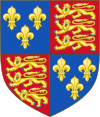
|
28 January 1457 Pembroke Castle Son of Edmund Tudor and Lady Margaret Beaufort |
Elizabeth of York Westminster Abbey 18 January 1486 eight children |
21 April 1509 Richmond Palace Aged 52 |
Great-great-great-grandson of
Edward III ( right of conquest) |
|
Henry VIII 21 April 1509 – 28 January 1547 |

|

|
28 June 1491 Greenwich Palace Son of Henry VII and Elizabeth of York |
Catherine of Aragon Greenwich 11 June 1509 one daughter |
28 January 1547 Whitehall Palace Aged 55 |
Son of
Henry VII ( primogeniture) |
|
Anne Boleyn Westminster Palace 25 January 1533 [1] one daughter | ||||||
|
Jane Seymour Whitehall Palace 30 May 1536 one son | ||||||
|
Anne of Cleves Greenwich Palace 6 January 1540 | ||||||
|
Catherine Howard Hampton Court Palace 28 July 1540 | ||||||
|
Catherine Parr Hampton Court Palace 12 July 1543 | ||||||
|
Edward VI 28 January 1547 – 6 July 1553 |

|

|
12 October 1537 Hampton Court Palace Son of Henry VIII and Jane Seymour |
Unmarried | 6 July 1553 Greenwich Palace Aged 15 |
Son of
Henry VIII ( primogeniture) |
Disputed claimant
Edward VI named Lady Jane Grey as his heir presumptive, overruling the order of succession laid down by Parliament in the Third Succession Act. Four days after his death on 6 July 1553, Jane was proclaimed queen—the first of three Tudor women to be proclaimed queen regnant. Nine days after the proclamation, on 19 July, the Privy Council switched allegiance and proclaimed Edward VI's Catholic half-sister Mary. Jane was executed in 1554, aged 16. Many historians do not consider her to have been a legitimate monarch.
| Name Reign |
Portrait | Arms | Birth | Marriage(s) Issue |
Death | Claim |
|---|---|---|---|---|---|---|
|
Jane 10 July 1553 – 19 July 1553 Title disputed |
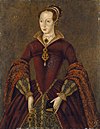
|
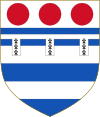
|
October 1537 Bradgate Park Daughter of Henry Grey, 1st Duke of Suffolk and Lady Frances Brandon |
Lord Guildford Dudley The Strand 21 May 1553 No children [2] |
12 February 1554 Tower of London Aged 16 (beheaded) |
Great-granddaughter of
Henry VII ( Devise for the succession) |
| Name Reign |
Portrait | Arms | Birth | Marriage(s) Issue |
Death | Claim |
|---|---|---|---|---|---|---|
|
Mary I 19 July 1553 – 17 November 1558 |

|
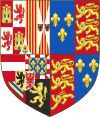
|
18 February 1516 Greenwich Palace Daughter of Henry VIII and Catherine of Aragon |
Philip II of Spain Winchester Cathedral 25 July 1554 No children |
17 November 1558 St James's Palace Aged 42 |
Daughter of
Henry VIII ( Third Succession Act) |
|
Philip
[3] 25 July 1554 – 17 November 1558 ( jure uxoris) |

|
21 May 1527 Valladolid, Spain Son of Charles V, Holy Roman Emperor and Isabella of Portugal |
(2)
Mary I of England Winchester Cathedral 25 July 1554 No children three other marriages and seven children |
13 September 1598 El Escorial, Spain Aged 71 |
Husband of
Mary I ( Act for the Marriage of Queen Mary to Philip of Spain) |
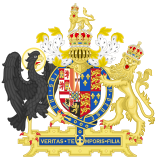
Under the terms of the marriage treaty between Philip I of Naples (Philip II of Spain from 15 January 1556) and Queen Mary I, Philip was to enjoy Mary's titles and honours for as long as their marriage should last. All official documents, including Acts of Parliament, were to be dated with both their names, and Parliament was to be called under the joint authority of the couple. An Act of Parliament gave him the title of king and stated that he "shall aid her Highness … in the happy administration of her Grace's realms and dominions" [4] (although elsewhere the Act stated that Mary was to be "sole queen"). Nonetheless, Philip was to co-reign with his wife. [5] As the new King of England could not read English, it was ordered that a note of all matters of state should be made in Latin or Spanish. [5] [6] [7] Coins were minted showing the heads of both Mary and Philip, and the coat of arms of England (right) was impaled with Philip's to denote their joint reign. [8] [9] Acts which made it high treason to deny Philip's royal authority were passed in England [10] and Ireland. [11] In 1555, Pope Paul IV issued a papal bull recognising Philip and Mary as rightful King and Queen of Ireland.
| Name Reign |
Portrait | Arms | Birth | Marriage(s) Issue |
Death | Claim |
|---|---|---|---|---|---|---|
|
Elizabeth I 17 November 1558 – 24 March 1603 |

|

|
7 September 1533 Greenwich Palace Daughter of Henry VIII and Anne Boleyn |
Unmarried | 24 March 1603 Richmond Palace Aged 69 |
Daughter of
Henry VIII ( Third Succession Act) |
House of Stuart (restored)
Following the restoration of the Monarchy, England came under the rule of Charles II whose reign was relatively peaceful domestically, given the tumultuous time of the Interregnum years. Tensions still existed between Catholics and Protestants however, and with the ascension of his brother, the openly Catholic James II, England again was sent into a period of political turmoil. James II was ousted by Parliament less than three years after ascending to the throne, and the throne was offered jointly to his daughter Mary and her husband (also his first cousin once removed) William during the Glorious Revolution. While James and his descendants would continue to claim the throne, all Catholics (such as James and his son Charles) were barred from the throne by the Act of Settlement 1701, enacted by Queen Anne, another of James's Protestant daughters. After the Acts of Union 1707, England as a sovereign state ceased to exist, replaced by the new Kingdom of Great Britain.
| Name Reign |
Portrait | Arms | Birth | Marriage(s) Issue |
Death | Claim |
|---|---|---|---|---|---|---|
|
Charles II 29 May 1660 – 6 February 1685 [12] Recognised by Royalists in 1649 |
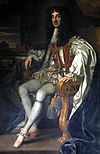
|
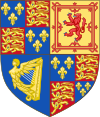
|
29 May 1630 St James's Palace Son of Charles I and Henrietta Maria of France |
Catherine of Braganza Portsmouth 21 May 1662 No children |
6 February 1685 Whitehall Palace Aged 54 |
Son of Charles I ( cognatic primogeniture; English Restoration) |
|
James II 6 February 1685 – 23 December 1688 (deposed) |
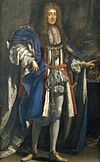
|

|
14 October 1633 St James's Palace Son of Charles I and Henrietta Maria of France |
(1)
Anne Hyde The Strand 3 September 1660 eight children (2)
Mary of Modena |
16 September 1701 Château de Saint-Germain-en-Laye Aged 67 |
Son of Charles I ( cognatic primogeniture) |
|
Mary II 13 February 1689 – 28 December 1694 |

|

|
30 April 1662 St James's Palace Daughter of James II and Anne Hyde |
St James's Palace 4 November 1677 No children |
28 December 1694 Kensington Palace Aged 32 |
Grandchildren of Charles I ( offered the crown by Parliament) |
|
William III William of Orange 13 February 1689 – 8 March 1702 |

|

|
4 November 1650 The Hague Son of William II, Prince of Orange, and Mary, Princess Royal [13] |
8 March 1702 Kensington Palace Aged 51 after breaking his collarbone from falling off his horse | ||
|
Anne 8 March 1702 – 1 May 1707 [14] Queen of Great Britain and Ireland ( 1 May 1707 – 1 August 1714) |
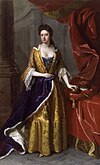
|

|
6 February 1665 St James's Palace Daughter of James II and Anne Hyde |
George of Denmark St James's Palace 28 July 1683 5 children |
1 August 1714 Kensington Palace Aged 49 |
Daughter of James II ( cognatic primogeniture; Bill of Rights 1689) |
| Monarchs after 1707 | See List of British monarchs | |||||
House of Hanover (1714–1901)
The Hanoverian succession came about as a result of the Act of Settlement 1701, passed by the Parliament of England, which excluded " Papists" (that is, Roman Catholics) from the succession. In return for access to the English plantations in North America and the West Indies, the Hanoverian succession and the Union were ratified by the Parliament of Scotland in 1707.
After the death of Queen Anne with no living children, George I, the son of Sophia of Hanover, granddaughter of James VI of Scotland and I of England through his daughter Elizabeth of Bohemia, was the closest heir to the throne who was not a Roman Catholic. [15]
| Name Reign |
Portrait | Arms | Birth Parentage |
Marriage(s) Issue |
Death | Succession right | Ref |
|---|---|---|---|---|---|---|---|
|
George I George Louis 1 August 1714 – 11 June 1727 |

|

|
28 May 1660 Leineschloss Son of Ernest Augustus, Elector of Brunswick-Lüneburg and Sophia of Hanover |
Sophia Dorothea of Brunswick-Lüneburg-Celle 21 November 1682 2 children |
11 June 1727 Osnabrück aged 67 |
Great-grandson of James VI and I, Act of Settlement, eldest son of Sophia of Hanover | [16] |
|
George II George Augustus 11 June 1727 – 25 October 1760 |
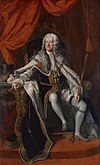
|

|
30 October 1683 Herrenhausen Son of George I and Sophia Dorothea of Brunswick-Lüneburg-Celle |
Caroline of Brandenburg-Ansbach 22 August 1705 8 children |
25 October 1760 Kensington Palace aged 76 |
Son of George I | [17] |
|
George III George William Frederick 25 October 1760 – 29 January 1820 |
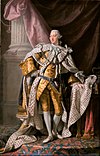
|
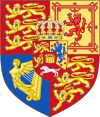
|
4 June 1738 Norfolk House Son of Frederick, Prince of Wales and Princess Augusta of Saxe-Gotha |
Charlotte of Mecklenburg-Strelitz St James's Palace 8 September 1761 15 children |
29 January 1820 Windsor Castle aged 81 |
Grandson of George II | [18] |
- ^ Edward Hall and Raphael Holinshed both record an earlier secret wedding between Henry and Anne, which was conducted in Dover on 15 November 1532.
- ^ "Lady Jane Grey: Marriage". Retrieved 25 October 2007.
- ^ Philip was not meant to be a mere consort; rather, the status of Mary I's husband was envisioned as that of a co-monarch during her reign. See Act for the Marriage of Queen Mary to Philip of Spain. However the extent of his authority and his status are ambiguous. The Act says that Philip shall have the title of king and "shall aid her Highness … in the happy administration of her Grace's realms and dominions," but elsewhere says that Mary shall be the sole Queen.
- ^ "Act for the Marriage of Queen Mary to Philip of Spain (1554)".
- ^ a b Louis Adrian Montrose, The subject of Elizabeth: authority, gender, and representation, University of Chicago Press, 2006
- ^ A. F. Pollard, The History of England – From the Accession of Edward VI. to the Death of Elizabeth (1547–1603), READ BOOKS, 2007
- ^ Wim de Groot, The Seventh Window: The King's Window Donated by Philip II and Mary Tudor to Sint Janskerk in Gouda (1557), Uitgeverij Verloren, 2005
- ^ Richard Marks, Ann Payne, British Museum, British Library; British heraldry from its origins to c. 1800; British Museum Publications Ltd., 1978
- ^ American Numismatic Association, The Numismatist, American Numismatic Association, 1971
- ^ Treason Act 1554
- ^ Robert Dudley Edwards, Ireland in the age of the Tudors: the destruction of Hiberno-Norman civilisation, Taylor & Francis, 1977
- ^ "Oliver Cromwell (1649-1658 AD)".
- ^ "WILLIAM III - Archontology.org". Retrieved 25 October 2007.
- ^ "Anne (England) - Archontology.org". Retrieved 25 October 2007.
- ^ For a family tree showing King George I's relationship to Queen Anne, see George I of Great Britain § Family tree
- ^ "George I". Official website of the British Monarchy. Retrieved 3 August 2010.
- ^ "George II". Official website of the British Monarchy. Retrieved 3 August 2010.
- ^ "George III". Official website of the British Monarchy. Retrieved 3 August 2010.